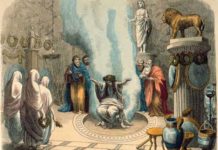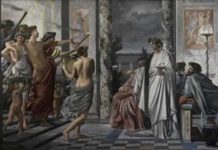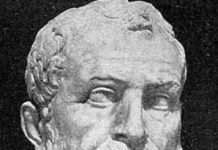Asclepius is a renowned figure in Greek mythology and his symbol (a staff with a snake wrapped around it) is still used in modern medicine.
One of the most fascinating elements of the story about Asclepius is the fact that he might have been an actual historical figure. According to the National Library of Medicine, although Asclepius is generally memorialized as a god, there is evidence which indicates that he might have been a real person who was not deified until later. Regardless of whether he existed or not, however, the bulk of the information that is available regarding Asclepius relates to the stories that are part of the vast web of Greek myth.
The Legend of Asclepius’ Birth
According to legend, Asclepius was the son of the Greek god Apollo and the mortal lake nymph named Coronis. While some nymphs are immortal, the sub-set to which Coronis belonged was not. As the story goes, Coronis took a mortal lover in secret and committed adultery against Apollo.
Out of anger, Apollo commanded his sister, Artemis, to kill Coronis (although some myths say that Apollo killed Coronis himself). As Coronis’ body burned on the funeral pyre, Apollo felt pity for his unborn son and rescued him from his mother’s corpse.
And, thus, this child was given the name “Asklepios” which is Greek for “to cut open.” After his birth, Apollo placed him in the care of Chiron, the leader of the centaurs (half-man and half-horse mythical creatures), who had also helped to raise the famous Greek warrior Achilles.
Medicinal Abilities
Under Chiron’s care, Asclepius refined his trade and discovered many of the secrets of medicine and healing. Some versions of the story say that the goddess Athena blessed him with a gift: two vials of blood from Medusa. Medusa was a Gorgon, a monstrous female creature, who had been cursed by Athena and made to be so ugly that whoever looked at her would turn to stone.
Medusa was the only mortal of the three Gorgons and her hair was made of writhing snakes. The blood from Medusa was said to have two purposes: if taken from the left side of the head, it was a deadly poison. If it was taken from the right side, however, it was able to bring the dead back to life.
With the blood of the Gorgon, Asclepius was able to surpass the knowledge and power of all other healers. He was said to have tested his power on Hippolytus, who died as a result of the lies of his mother and ignorance of his father. Hippolytus’ step-mother fell in love with him, and when he rejected her advances, she convinced Hippolytus’ father (Theseus) that Hippolytus had raped her.
Theseus thus cursed Hippolytus, and he was dragged to his death by his horses when they were spooked. After Asclepius had revived Hippolytus, the most powerful god in the Pantheon, Zeus, began to grow concerned about Asclepius’ developing power.
Asclepius’ Death
Zeus feared that Asclepius would begin restoring the lives of those who had passed and would close the gap between the mortals and gods. As a result, Zeus struck Asclepius down with a thunderbolt and killed him. Apollo was so angry at the death of his child that he sought revenge by killing the Cyclops who had fashioned the thunderbolt. Ultimately, Zeus made Asclepius immortal (some sources say that this action was at Apollo’s request) and he was placed among the stars as the constellation Ophiuchus, the “Serpent Bearer.”
Modern Implications of the Story of Ascelpius
The story of Asclepius continues to be told today, and it has far-ranging effects from the field of medicine to the field of astronomy. One of the most noticeable impacts is in the field of medicine. There are two symbols of medicine that are widely known in the world today: the Caduceus of Hermes and the rod of Asclepius.
Although the Caduceus is generally more widely seen in North American medicine, the rod of Asclepius, which is a staff that features a single snake wrapped around it, is a worldwide symbol of medicine. The snake is thought to have been used as a symbol of renewal and restoration, since snakes are able to slough their old skin and begin anew. As such, the rod of Asclepius has a prominent place in global medicine and is featured in the logo of the World Health Organization.
In addition to the impact on medicine, the story of Asclepius has also been highlighted in the field of astronomy. In January 2011, Professor Parke Kunkle from the Minneapolis Community and Technical College sparked controversy when he indicated that the modern zodiac chart has neglected a thirteenth sign: Ophiuchus, the Serpent Bearer. As such, the story of Asclepius is once again in the news as interested readers and dedicated astrology fans clamber to find out if their astrological sign has changed.
The fascination with the story of Asclepius has existed for hundreds of years and, especially given the modern implications of his life and death, it seems that this story will continue to be told for hundreds of years to come.








